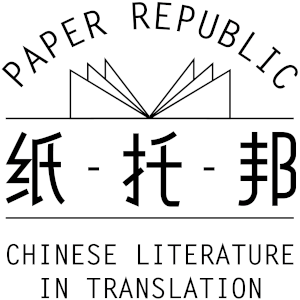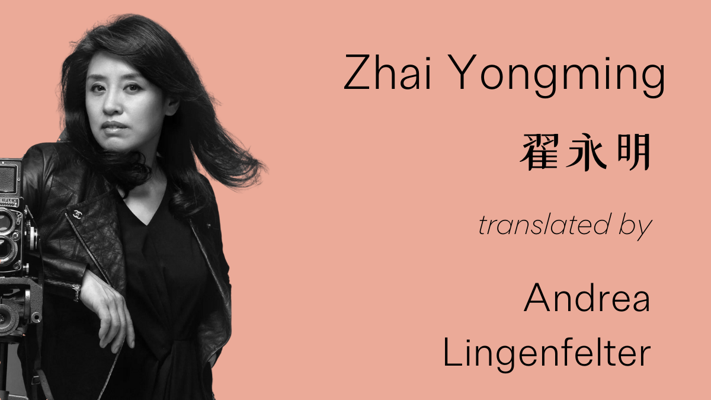I
In 1350, hand scrolls were cinema
you lean over and unroll it towards me
ink and scene unfold in a leisurely rhythm
the lens tracks, pans
over the space between fingers and palms
Moving past a colophon the size of a thumb
entering the painting’s bony, craggy heart
I become a figure in dense and diluted ink
taking in the mountains
following Huang Gongwang seeking Master Wuyong visiting the Fuchun mountains
That year, he was nearly eighty
“Before the fall of rustling leaves one already feels desolate
Walk with me across all six sheets of xuan paper, we’ll drop our fishing lines right here
These are not our twilight years”
I carry a stack of A4 paper, blue ballpoint pen
intrude on the rarefied air of the Remaining Mountain
falling leaves rustle I too am desolate
Remaining Mountain has grown old I too grow old
Poet’s notes
Line 2: In the poem, I imagined Huang Gongwang unrolling the scroll for a friend. The fashion in which a scroll unrolls horizontally from right to left allows the viewer’s gaze to move in a leisurely way, as if narrating a composition, which leads us to follow the painter’s journey through the landscape. Dong Qichang [(1555 – 1636, a late Ming painter, collector, and art critic who owned the scroll at one point)] remarked that when he looked at this painting, he felt “untrammeled in body and mind.” I felt this as well.
Line 10: It’s said that Huang Gongwang was 79 years old when he made this painting. He had returned home to the Fuchun Mountains from Songjiang, and he turned his hand to the painting of this long scroll in the southern building of his mountain retreat. However, he also often went out to make sketches or to simply roam the mountains. As a result, the scroll remained at his place in the mountains, and he could only “come back to it and bit by bit add a dab here and there,” which is why “he was unable to finish it within a space of 3 to 4 years.” When Huang Gongwang was 83 years old, Master Wuyong asked him to write an inscription on the painting to clarify its ownership, but the completion date for the painting is nonetheless hard to pin down. In the Qing dynasty, Wang Yuanqi, in “Notes on Painting from Lu Terrace,” says that it took Huang Gongwang seven years to finish the painting. If this claim could be confirmed, then we might also be able to conclude that, in the entire history of Chinese painting, this long scroll took the longest to paint and underwent the most revision.
壹
一三五〇年,手卷即电影
你引首向我展开1
墨与景 缓缓移动
镜头推移、转换
在手指和掌肌之间
走过拇指大小的画题
走进瘦骨嶙峋的画心
我变成那个浓淡人儿
俯仰山中
随黄公望 寻无用师 访富春山2
那一年,他年近八十
“不待落木萧萧 人亦萧条
随我走完六张宣纸,垂钓此地
那便不是桑榆晨昏”
我携一摞A4白纸,蓝色圆珠笔
闯进剩山冷艳之气
落叶萧萧 我亦萧条
剩山将老 我亦将老
1 我在诗中想象了黄公望向朋友展开长卷的情景。手卷从右往左的独特的横向展开方式,可以让观者的视点在手卷中缓缓移动,如同叙事一般的布局,引导我们跟随画家在山水中游历。董其昌曾说,他看了此画,觉得“心脾俱畅”,我竟也如此。
2 据说黄公望作此画时已七十九岁,一次,从松江归富春山居,于山居南楼着手绘此长卷。但他经常出外写生或云游,画卷则留在山中,只得“逐旋填劄”, 故“阅三四载未得完备”。黄公望八十三岁时,无用请他在画中题文,明确归属,而画作完成的具体日期,已难以确定。清王原祁在《麓台题画稿》中说是经营七年而成,若此说成立,不知可否认定这是中国绘画史上绘制最久,来回修改补订最多的长卷。
V
Squeezed into a crevice between Heaven and Earth: bored twentysomethings idle in Internet cafés
no longer remember the way home
They’ve stopped smoking
stopped resisting
stopped going places
A virtual “self” appears
the “self” gets hooked on a glass of something blue
brains sleep deeply nerves fire reflexively
keyboards to the left and right alter their glandular secretions
Other than airplanes, the soaring feeling of birds is no more
Other than black and white, the moon no longer casts its rays
I am no longer my “self”
Other than high-speed data retrieval
information no longer threads through our minds
A sudden electrical shock your flesh deserts you
drowning your heart in the translucent orbs of your eyes
freezing it in a final lament of the soul — “Ai!”
伍
天地一容膝:枯坐在网吧的90后
也不记得归路
他们不再抽烟
不再抵抗 也不再上路
一个虚拟的“我”现身
一杯蓝色饮品让“我”上瘾
大脑沉睡 反射神经依然活跃
左键右键改变人的肾上腺素
除了飞机,已没有鸟的腾空感
除了黑白,月亮不再生辉
“我”不再是我
除了快速检索
信息在大脑中布线
突然你触电 肉体离开
将心沉溺于透明眼球
凝固于灵魂最后那一声“嗨”
VI
What makes me hold my breath for moment and then
keen in harmony
makes the creative forces of Heaven and Earth fill my lungs
and opens a child’s heart
What holds me spellbound for a moment and then
frees me from care to alight on the paper
fixes the power of the image in dots, lines, planes
expansive brushstrokes create time for deep thought out of ink wash
What makes me lose heart for a moment and then
concentrates my attention at length
makes images of stones, slopes, barren trees
enter the body, harmony of dense and sparse
What makes me breathe easy for a moment and then
loosens every bone in my body
Breath let out from deep in my lungs
breath that reaches the clouds
陆
让我屏息一小会儿
长啸半声
让氲氤之气落在人肺中
开出儿童之心
让我出神一小会儿
跳脱焦虑至纸上
让图像的威力固定在点、线、面
阔笔晕染出一段潜修时间
让我气馁一小会儿
专注半晌
让岩石、坡地、枯干的意象
进入身体,疏密有致
让我吐气一小会儿
把百骸打开
一呼自丹田
再呼上云端
VII
at the last moment like an angry dark red flower
his coronary artery exploded in fury
frail bones rattling and clanking
like mountains shaking seas spilling out the spreading blood
bored into that desperately grasping heart
heavy ink watery black
bluegreen moss broken moss
dead grey steel grey
stippling crosshatching
I can only apologize
a breath blows my way
the narrator demands those signatures
you mustn’t doubt my misgivings
where I am going it cannot follow
last night I reached for its glory
and it refused to vanish with the wind
refused to become part of me refused
to be over like a life like a human being
by its very nature it cannot choose mortality
Poet’s notes
Yun Nantian, in his Ouxiang Hall colophon to the painting recounts: When the country was in upheaval during the “change of dynasties”, Wu Hongyu left behind the bulk of his property and collection [of art and antiquities] and fled with nothing but Dwelling in the Fuchun Mountains and the [Sui dynasty calligraphy master] Master Shiyong’s Authentic One Thousand Character Classic.
In the seventh Shunzhi year of the Qing dynasty (1650), when Wu Hongyu lay on his deathbed, he instructed his family to take his beloved Fuchun scroll and “burn it as a funerary sacrifice”: “On the first day they burned the Thousand Character Classic and Wu looked on as it was completely consumed by the flames. The next day, Dwelling in the Fuchun Mountains was put in the fire, sacrificial wine was added to stoke the flames, and when the fire was burning robustly, Wu Hongyu went to lie down in his room.”
By the time Wu Hongyu’s nephew Wu Jing’an was able to snatch the scroll from the fire, it had already been burned into two pieces, one long and one short; afterwards, the pieces were reassembled and remounted, the smaller portion consisting of nothing but ‘one mountain, one river, one hill, and one ravine’; later generations would refer to this section as the ‘Leftover Mountain’ painting.
In this poem, the ‘it’ referred to is always a reference to this painting which “refused to vanish with the wind.”
柒
最后时刻 冠状动脉像
暗红花朵怒放
瘦骨铮铮作响
排山倒海的淤血
钻进一颗狂狷之心
浓墨 淡漠
青苔 碎苔
死灰 铁灰
点状 网状
不过意思而已
一口呼吸转向我
叙述者索要那些签名
你不能怀疑我的疑虑
我要去的地方 它不能跟随
昨晚 我将手指向那个美好1
它完全拒绝随风飘逝
拒绝成为我的一部分 拒绝
像生命一样结束 像人
木质上 无法选择生死
1 恽南田《瓯香馆画跋》中记:吴洪裕于“国变时”置其家产和大部分收藏于不顾,唯独随身带了《富春山居图》和《智永法师千字文真迹》逃难。
清顺治七年(1650),卧病在床的吴洪裕于弥留之际,嘱家人将他极真爱的《富春山居图》“焚以为殉”:“先一日焚《千字文真迹》,自己亲视其焚尽。翌日即焚《富春山居图》,当祭酒以付火,到得火盛,洪裕便还卧内。”
吴洪裕的侄子吴静庵将其抢下后,画已被烧为一长一短的两截,后经重心接拼和装裱,短的一部分正好留有“一山一水一丘一壑”之景,后世便称其为《剩山图》。
这段诗歌中所有的“它”,都是指“拒绝随风飘逝”的画作。
XXI
I tell a painting “I’m waiting”
the mountains and waters do not reply I forge ahead —
soft steps slow pace rambling
I could be a village wife a village auntie
or a woman knight errant I could also be
a gatherer of herbs or a woman Daoist
With the form of a woman, I walk the space between clouds and water
With a woman’s montage, I unfold and advance along the level surface
With a woman’s vision, I watch time flicker, now far, now near
I have no attachments but I have a “differentiating mind”
my whole body is but a few inky brushstrokes but my skeleton remains —
In this age of images I read
about what others have scrapped about industry
Who is that? Dressed like ET
dressed in a metal suit taking a walk in space
I spin and my gaze takes in
the minerals of the universe arranged into something wondrous
In this age of images I read
Russian tanks rolling into Ukraine
Who is that? Clad in a black cloak
holding a crescent shaped scythe?
Behind him are the fallen, the mortally wounded
That is the border of the grand collision where centuries collide and flee
the border where weird Internet wars ignite
It’s the unfixed border where four-dimensional space is swallowed up
the border where spring is laid waste the moment it opens its eyes
the most beautiful most awkward forsaken border
enchanting, dispiriting
the border so massive it’s hard to see
The more I am still the more it is restless
Do the fires of war linger?
Are families being scattered?
I weep bitterly and it
is unmoved
贰拾壹
我对一幅画说“我等待”
山水不回应 我亦然迈进——
轻步 慢踱 悠行
我可以是村妇是村姑
也可以是一个侠女 我可以是
采药人 也可以是一个女道士
我以女人的形象走在云水间
以女人的蒙太奇平拉推移
以女人的视觉看时间忽远忽近
我不执着 但有“分别心”
我全身笔墨均少 但骨架依存——
读图时代 我读到
报废的题材 工业题材
那是何人?穿E.T.衣
着金属装 走太空步?
我转动纵目
看到宇宙矿物排列成奇观
读图时代 我读到
俄罗斯坦克开进乌克兰
那是何人?穿黑大氅
持明月弯刀?
背后是倒地不起的死者伤员
那是诸世纪交叉跑动的大撞击边缘
是不着调的网络战争起火的边缘
那是四维空间吞吐不定的边缘
青春睁开眼就被毁灭的边缘
最美的最拧巴的被弃边缘
引人入胜、又令人丧气
又大又看不清的边缘
我越静 它越动
战火是否缠绵?
家庭在离散?
我痛苦 它
漠然!





Comments
There are no comments yet.